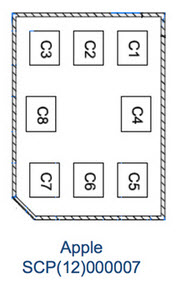Why Apple, RIM, Nokia and Motorola are arguing over what your next SIM card will look like

Apple, RIM, Motorola and Nokia are locked in a debate over something that you and I probably think of as rather trivial -- what your next SIM card will look like.
The European Telecommunications Standards Institute (ETSI), the body responsible for worldwide SIM standardization, approached handset manufacturers for designs for the next-generation 4FF (fourth form factor) nano-SIM, a replacement for the 3FF (third form factor) micro-SIM used in handsets such as the iPhone 4/4S and tablets such as the iPad.
This is what Apple wants your next SIM card to look like.

And this is the latest design submitted to the ETSI by RIM, Nokia and Motorola.
You might look at the two designs above and wonder why the handset manufacturers are getting worked up about Apple's design. After all, it looks simpler than the one offered up by Motorola, Nokia and RIM.
The reason comes down to dollars and cents. Apple's SIM design would result in handsets costing more to manufacturer because the SIM card design requires a drawer or tray in order to insert it into the device, while the RIM, Nokia and Motorola design can be popped in and out of a SIM slot without the need for a tray or drawer.
A SIM tray or drawer might only cost a few cents, but the tools needed to machine or mold such a holder costs millions to tool. For Apple, which sells a high-end smartphone pulling in $100+ profit per handset, these costs are minute, but for makers selling a cheap phone with razor-thin margins, every penny counts.
In other words, Apple's offering of a royalty-free SIM card design is a Trojan horse. If the ETSI committee vote for Apple's design, it will end up being a gift that eats into the competition's profit margins.
Another reason why RIM, Nokia and Motorola don't like Apple's design is because they claim that it requires more space on the logic board.
A smaller connector footprint on the logic board offers more scope for miniaturization, and cheaper logic board connectors.
A simpler design is not necessarily better.
Image source: RIM March 2012 nano-SIM slide deck via The Verge.
Related:
- The case against the 'iPad mini': Fragmentation and cannibalization
- Reuters: iPhone 5 to have 4-inch screen
- WSJ: iPhone 5 getting 4-inch+ screen
- Who cares that the iPad 3 is thicker and heavier than the iPad 2?
- iPhone touch panel shipments to fall 15-20 percent in Q2 2012
- Best earphones for your iPhone and iPad
- Jailbroken iPads can now multitask apps
- Top accessories for your iPhone and iPad
- 100 reasons to jailbreak an iPhone